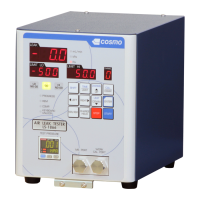26 5 INSTALLATION
5) Use of O-ring
If there is an air space that isn’t pressurized at the side of the O-ring, the O-ring will move and causes a
pressure drop. If O-ring groove is so tight, the fixture cannot touch the metal surface of the tested part,
which results in damage to the O-ring or erratic reading due to spongy fixturing.
6) Use of flat rubber seal
Use a positive stop to prevent deformation of seal packing when
using air or oil cylinders as a clamping mechanism. A metal
stopper helps seal packing to stabilize perfectly because normally
the clamping pressure added to the seal packing causes the
packing to move intermittently.
7) Combining with water dunk test
Temperature effects
Temperature changes of tested part and/or fixture after submerging them under water may temporarily
affect tester reading.
Tester malfunction due to water contamination
Tester may get contaminated by water causing tester malfunction at exhaust process of water dunk test.
To avoid the trouble, use the following precautions:
• While the part is submerged, the tester should always be on charge hold. Never exhaust air while
the tested part is submerged under water.
• Put an external exhaust valve between the tester and the tested part (Refer to 4.5.2 → )
• I
nstall leak tester higher level than water surface.
8) Using multiple leak testers on a single system
To ensure that the all the clamping fixtures do not interfere each other, build each one of them
independently. Also be sure to put regulator independently. ((See Section 4.7 → )
9) Testing multiple independent measurement points (Exhaust interference control)
If one leak tester exhausts while a measurement is in progress, variations in the clamp seal could
influence the measurement accuracy of the other leak testers. Mutual exhaust interference can be
prevented by performing exhaust on all leak testers concurrently. This leak tester allows external
control of the exhaust timing (see Section 4.8 → ).
10) T
ested parts that are liable to deformation
Have a restraint installed to eliminate deformation.
11) Fixture pressure supply port
Provide a port where dust, oil, and water will not be accumulated.
If the sealing surface of the tested part is varied in angle, have a floating mechanism mounted on the
clamp shaft.

